Mechanical, Anisotropic, and Electronic Properties of XN (X = C, Si, Ge): Theoretical Investigations
Abstract
:1. Introduction
2. Materials and Methods
3. Discussion
3.1. Structural Properties
3.2. Mechanical Properties
3.3. Electronic Properties
3.4. Elastic Anisotropy Properties
4. Conclusions
Acknowledgments
Author Contributions
Conflicts of Interest
References
- Fang, C.M.; de Wijs, G.; Hintzen, H.T.; de With, G. Phonon spectrum and thermal properties of cubic Si3N4 from first-principles calculations. J. Appl. Phys. 2003, 93, 5175–5180. [Google Scholar] [CrossRef]
- Riley, F.L. Silicon Nitride and Related Materials. J. Am. Ceram. Soc. 2000, 83, 245–265. [Google Scholar] [CrossRef]
- Horvath-Bordon, E.; Riedel, R.; Zerr, A.; McMillan, P.F.; Auffermann, G.; Prots, Y.; Bronger, W.; Kniep, R.; Kroll, P. High-pressure chemistry of nitride-based materials. Chem. Soc. Rev. 2006, 35, 987–1014. [Google Scholar] [CrossRef] [PubMed]
- Zerr, A.; Riedel, R.; Sekine, T.; Lowther, J.E.; Ching, W.Y.; Tanaka, I. Recent advances in new hard high-pressure nitrides. Adv. Mater. 2006, 18, 2933–2948. [Google Scholar] [CrossRef]
- Xu, B.; Dong, J.; McMillan, P.; Shebanova, O.; Salamat, A. Equilibrium and metastable phase transitions in silicon nitride at high pressure: A first-principles and experimental study. Phys. Rev. B 2011, 84, 014113. [Google Scholar] [CrossRef]
- Kuwabara, A.; Matsunaga, K.; Tanaka, I. Lattice dynamics and thermodynamical properties of silicon nitride polymorphs. Phys. Rev. B 2008, 78, 064104. [Google Scholar] [CrossRef]
- Zerr, A.; Kempf, M.; Schwarz, M.; Kroke, E.; Goken, M.; Riedel, R. Elastic Moduli and Hardness of Cubic Silicon Nitride. J. Am. Ceram. Soc. 2002, 85, 86–90. [Google Scholar] [CrossRef]
- Ching, W.; Mo, S.D.; Ouyang, L.Z.; Rulis, P. Theoretical prediction of the structure and properties of cubic spinel nitrides. J. Am. Ceram. Soc. 2002, 85, 75–80. [Google Scholar] [CrossRef]
- Weihrich, R.; Eyert, V.; Matar, S.F. Structure and electronic properties of new model dinitride systems: A density-functional study of CN2, SiN2, and GeN2. Chem. Phys. Lett. 2003, 373, 636–641. [Google Scholar] [CrossRef]
- Johnson, W.C. Nitrogen compounds of germanium I. the preparation and properties of germanic nitride. J. Am. Chem. Soc. 1930, 52, 5160–5165. [Google Scholar] [CrossRef]
- Salamat, A.; Woodhead, K.; McMillan, P.F.; Cabrera, R.Q.; Rahman, A.; Adriaens, D.; Corà, F.; Perrillat, J.P. Tetrahedrally bonded dense C2N3H with a defective wurtzite structure: X-ray diffraction and Raman scattering results at high pressure and ambient conditions. Phys. Rev. B 2009, 80, 397–403. [Google Scholar] [CrossRef]
- Manyali, G.S.; Warmbier, R.; Quandt, A. Computational study of the structural, electronic and optical properties of M2N2(NH): M = C, Si, Ge, Sn. Comput. Mater. Sci. 2013, 79, 710–714. [Google Scholar] [CrossRef]
- Yu, B.H.; Chen, D. First-principles study on the electronic structure and phase transition of α-, β- and γ-Si3N4. Acta Phys. Sin. 2012, 19, 197102. [Google Scholar]
- Manyali, G.S.; Warmbier, R.; Quandt, A.; Lowther, J.E. Ab initio study of elastic properties of super hard and graphitic structures of C3N4. Comput. Mater. Sci. 2014, 69, 229–303. [Google Scholar] [CrossRef]
- Fan, Q.Y.; Chai, C.C.; Wei, Q.; Yang, Y.T. The mechanical and electronic properties of carbon-rich silicon carbide. Materials 2016, 9, 333. [Google Scholar] [CrossRef] [PubMed]
- Xu, X.Y.; Chai, C.C.; Fan, Q.Y.; Yang, Y.T. Theoretical prediction of new C–Si alloys in C2/m-20 structure. Chin. Phys. B 2017, 26, 046101. [Google Scholar] [CrossRef]
- Wang, Q.K.; Chai, C.C.; Fan, Q.Y.; Yang, Y.T. Physical properties of C-Si alloys in C2/m structure. Commun. Theor. Phys. 2017, 68, 259–268. [Google Scholar] [CrossRef]
- Li, Q.; Liu, H.Y.; Zhou, D.; Zheng, W.T.; Wu, Z.J.; Ma, Y.M. A novel low compressible and superhard carbon nitride: Body-centered tetragonal CN2. Phys. Chem. Chem. Phys. 2012, 14, 13081–13087. [Google Scholar] [CrossRef] [PubMed]
- Wang, X.L.; Bao, K.; Tian, F.B.; Meng, X.; Chen, C.B.; Dong, B.W.; Li, D.; Liu, B.B.; Cui, T. Cubic gauche-CN: A superhard metallic compound predicted via first-principles calculations. J. Chem. Phys. 2010, 133, 044512. [Google Scholar] [CrossRef] [PubMed]
- Wei, Q.; Zhang, Q.; Yan, H.Y.; Zhang, M.G. Cubic C3N: A new superhard phase of carbon-rich nitride. Materials 2016, 9, 840. [Google Scholar] [CrossRef] [PubMed]
- Hao, J.; Liu, H.Y.; Lei, W.W.; Tang, X.; Lu, J.; Liu, D.; Li, Y.W. Prediction of a Superhard Carbon-rich C-N Compound Comparable to Diamond. J. Phys. Chem. C 2015, 119, 28614–28619. [Google Scholar] [CrossRef]
- George, S.M.; Robert, W.; Alexander, Q. First-principles studies of the structural, electronic and optical properties of dinitrides CN2, SiN2 and GeN2. Comput. Mater. Sci. 2014, 95, 706–711. [Google Scholar]
- George, S.M.; Robert, W.; Alexander, Q. First-principles study of Si3N2. Comput. Mater. Sci. 2015, 96, 140–145. [Google Scholar]
- Luo, Y.S.; Cang, Y.P.; Chen, D. Determination of the finite-temperature anisotropic elastic and thermal properties of Ge3N4: A first-principles study. Comput. Condens. Matter 2014, 1, 1–7. [Google Scholar] [CrossRef]
- Khan, G.G.; Clark, S.J.; Bandyopadhyay, N.R. Electronic, mechanical and optical properties of Si3P4 and Ge3P4: An ab initio study. Int. J. Mod. Phys. B 2010, 28, 5487–5494. [Google Scholar] [CrossRef]
- Wei, Q.; Zhang, M.G.; Yan, H.Y. First-principles investigation of high pressure Pbca phase of carbon mononitride. Phys. Lett. A 2016, 380, 3217–3221. [Google Scholar] [CrossRef]
- Hohenberg, P.; Kohn, W. Inhomogeneous electron gas. Phys. Rev. 1964, 136, B864. [Google Scholar] [CrossRef]
- Kohn, W.; Sham, L.J. Self-consistent equations including exchange and correlation effects. Phys. Rev. 1965, 140, A1133. [Google Scholar] [CrossRef]
- Clark, S.J.; Segall, M.D.; Pickard, C.J.; Hasnip, P.J.; Probert, M.I.J.; Refson, K.; Payne, M.C. First principlesmethods using CASTEP. Z. Kristallogr. 2005, 220, 567–570. [Google Scholar]
- Perdew, J.P.; Burke, K.; Ernzerhof, M. Generalized gradient approximation made simple. Phys. Rev. Lett. 1996, 77, 3865–3868. [Google Scholar] [CrossRef] [PubMed]
- Perdew, J.P.; Ruzsinszky, A.; Csonka, G.I.; Vydrov, O.A.; Scuseria, G.E.; Constantin, L.A.; Zhou, X.; Burke, K. Restoring the density-gradient expansion for exchange in solids and surfaces. Phys. Rev. Lett. 2008, 100, 136406. [Google Scholar] [CrossRef] [PubMed]
- Ceperley, D.M.; Alder, B.J. Ground state of the electron gas by a stochastic method. Phys. Rev. Lett. 1980, 45, 566–568. [Google Scholar] [CrossRef]
- Perdew, J.P.; Zunger, A. Self-interaction correction to density-functional approximations for many-electron systems. Phys. Rev. B 1981, 23, 5048–5079. [Google Scholar] [CrossRef]
- Monkhorst, H.J.; Pack, J.D. Special points for brillouin-zone integrations. Phys. Rev. B 1976, 13, 5188–5192. [Google Scholar] [CrossRef]
- Pfrommer, B.G.; Côté, M.; Louie, S.G.; Cohen, M.L. Relaxation of crystals with the quasi-newton method. J. Comput. Phys. 1997, 131, 233–240. [Google Scholar] [CrossRef]
- Baroni, S.; de Gironcoli, S.; dal Corso, A.; Giannozzi, P. Phonons and related crystal properties from density-functional perturbation theory. Rev. Mod. Phys. 2001, 73, 515–562. [Google Scholar] [CrossRef]
- Heyd, J.; Scuseria, G.E.; Ernzerhof, M. Hybrid functionals based on a screened Coulomb potential. J. Chem. Phys. 2003, 118, 8207–8215. [Google Scholar] [CrossRef]
- Heyd, J.; Scuseria, G.E.; Ernzerhof, M. Hybrid functionals based on a screened Coulomb potential. J. Chem. Phys. 2006, 118, 8207–8215, Erratum in J. Chem. Phys. 2006, 124, 219906. [Google Scholar] [CrossRef]
- Khazaei, M.; Tripathi, M.N.; Kawazoe, Y. First-principles simulation of cyanogen under high pressure: Formation of paracyanogen and an insulating carbon nitride solid. Phys. Rev. B 2011, 83, 134111. [Google Scholar] [CrossRef]
- Tkatchenko, A.; Scheffler, M. Accurate molecular van der waals interactions from ground-state electron density and free-atom reference data. Phys. Rev. Lett. 2009, 102, 073005. [Google Scholar] [CrossRef] [PubMed]
- Fan, Q.Y.; Wei, Q.; Chai, C.C.; Yan, H.Y.; Zhang, M.G.; Lin, Z.Z.; Zhang, Z.X.; Zhang, J.Q.; Zhang, D.Y. Structural, mechanical, and electronic properties of P3m1-BCN. J. Phys. Chem. Solids 2015, 79, 89–96. [Google Scholar] [CrossRef]
- Xing, M.J.; Li, B.H.; Yu, Z.T.; Chen, Q. Monoclinic C2/m-20 carbon: A novel superhard sp3 carbon allotrope. RSC Adv. 2016, 6, 32740–32745. [Google Scholar] [CrossRef]
- Ma, Z.Y.; Han, Z.; Liu, X.H.; Yu, X.H.; Wang, D.Y.; Tian, Y. Pnma-BN: Another Boron Nitride polymorph with interesting physical properties. Nanomaterials 2017, 7, 3. [Google Scholar] [CrossRef] [PubMed]
- Petrescu, M.L. Boron nitride theoretical hardness compared to carbon polymorphs. Diamond Relat. Mater. 2004, 13, 1848–1853. [Google Scholar] [CrossRef]
- Mouhat, F.; Coudert, F.X. Necessary and sufficient elastic stability conditions in various crystal systems. Phys. Rev. B. 2014, 90, 224104. [Google Scholar] [CrossRef]
- Cang, Y.P.; Lian, S.B.; Yang, H.M.; Chen, D. Predicting physical properties of tetragonal, monoclinic and orthorhombic M3N4 (M = C, Si, Sn) polymorphs via first-principles calculations. Chin. Phys. Lett. 2016, 33, 066301. [Google Scholar] [CrossRef]
- Chen, D.; Cheng, K.; Qi, B.Y. The electronic, optical, and thermodynamical properties of tetragonal, monoclinic, and orthorhombicM3N4 (M = Si, Ge, Sn): A first-principles study. Chin. Phys. B. 2017, 26, 046303. [Google Scholar] [CrossRef]
- Pugh, S.F. Relations between the elastic moduli and the plastic properties of polycrystalline pure metals. Philos. Mag. 1954, 45, 823–843. [Google Scholar] [CrossRef]
- Duan, Y.H.; Sun, Y.; Peng, M.J.; Zhou, S.G. Anisotropic elastic properties of the Ca–Pb compounds. J. Alloy. Compd. 2014, 595, 14–21. [Google Scholar] [CrossRef]
- Hao, Y.J.; Chen, X.R.; Cui, H.L.; Bai, Y.L. First-principles calculations of elastic constants of c-BN. Physica B 2006, 382, 118–122. [Google Scholar] [CrossRef]
- Anderson, O.L. A simplified method for calculating the debye temperature from elastic constants. J. Phys. Chem. Solids 1963, 24, 909–917. [Google Scholar] [CrossRef]
- Fan, Q.Y.; Wei, Q.; Yan, H.Y.; Zhang, M.G.; Zhang, Z.X.; Zhang, J.Q.; Zhang, D.Y. Elastic and electronic properties of Pbca-BN: First-principles calculations. Comput. Mater. Sci. 2014, 85, 80–87. [Google Scholar] [CrossRef]
- Fan, Q.Y.; Chai, C.C.; Wei, Q.; Zhou, P.K.; Yang, Y.T. Elastic anisotropy and electronic properties of Si3N4 under pressures. AIP Adv. 2016, 6, 085207. [Google Scholar] [CrossRef]
- Marmier, A.; Lethbridge, Z.A.D.; Walton, R.I.; Smith, C.W.; Parker, S.C.; Evans, K.E. ElAM: A computer program for the analysis and representation of anisotropic elastic properties. Comput. Phys. Commun. 2010, 181, 2102–2115. [Google Scholar] [CrossRef] [Green Version]
- Zhao, Y.R.; Zhang, H.R.; Zhang, G.T.; Wei, Q.; Yuan, Y.Q. First-principles investigation on elastic and thermodynamic properties of Pnnm-CN under high pressure. AIP Adv. 2016, 6, 125040. [Google Scholar] [CrossRef]
- Hu, W.C.; Liu, Y.; Li, D.J.; Zeng, X.Q.; Xu, C.S. First-principles study of structural and electronic properties of C14-type Laves phase Al2Zr and Al2Hf. Comput. Mater. Sci. 2014, 83, 27–34. [Google Scholar] [CrossRef]
- Ranganathan, S.I.; Ostoja-Starzewski, M. Universal elastic anisotropy index. Phys. Rev. Lett. 2008, 101, 055504. [Google Scholar] [CrossRef] [PubMed]
- Fan, Q.Y.; Chai, C.C.; Wei, Q.; Yang, Y.T. Two novel C3N4 phases: Structural, mechanical and electronic properties. Materials 2016, 9, 427. [Google Scholar] [CrossRef] [PubMed]
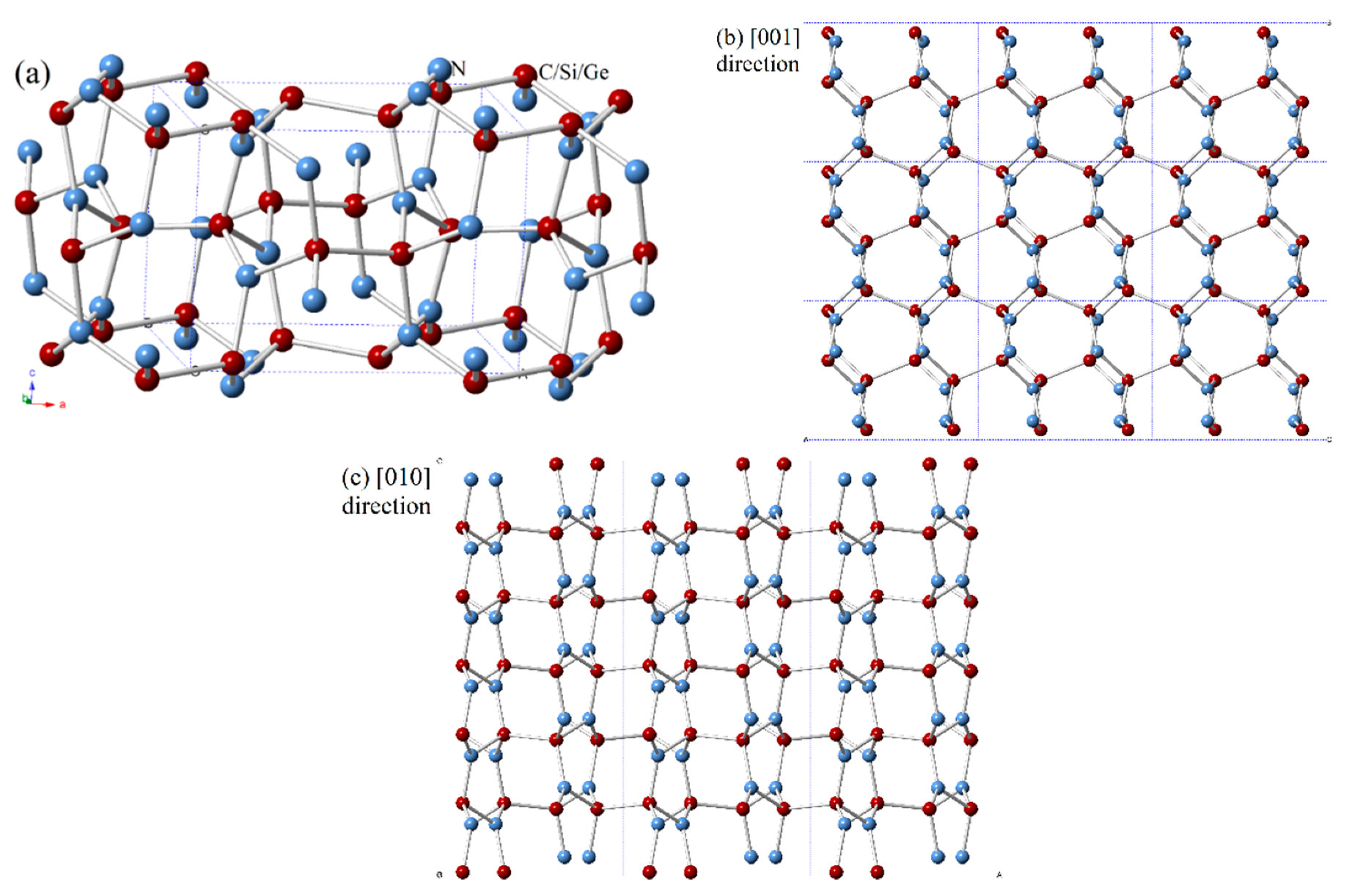

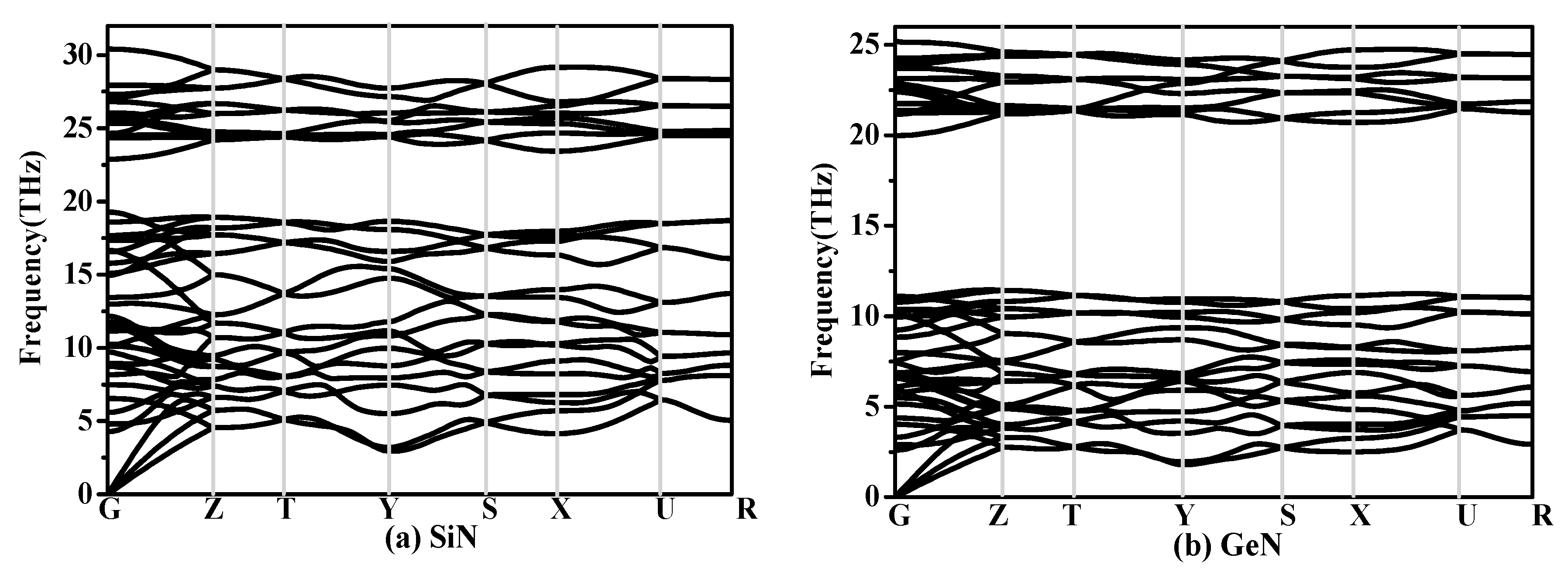
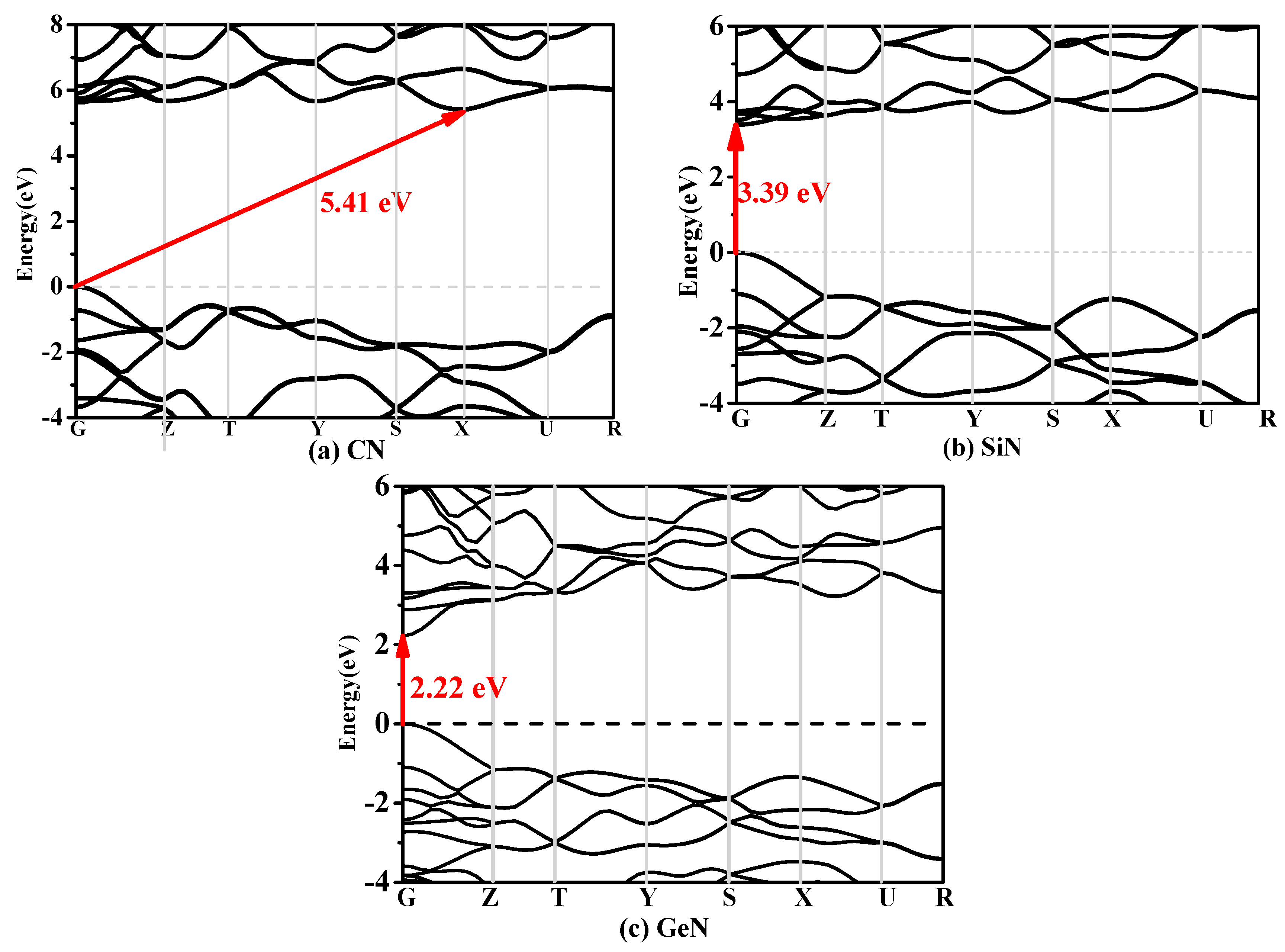


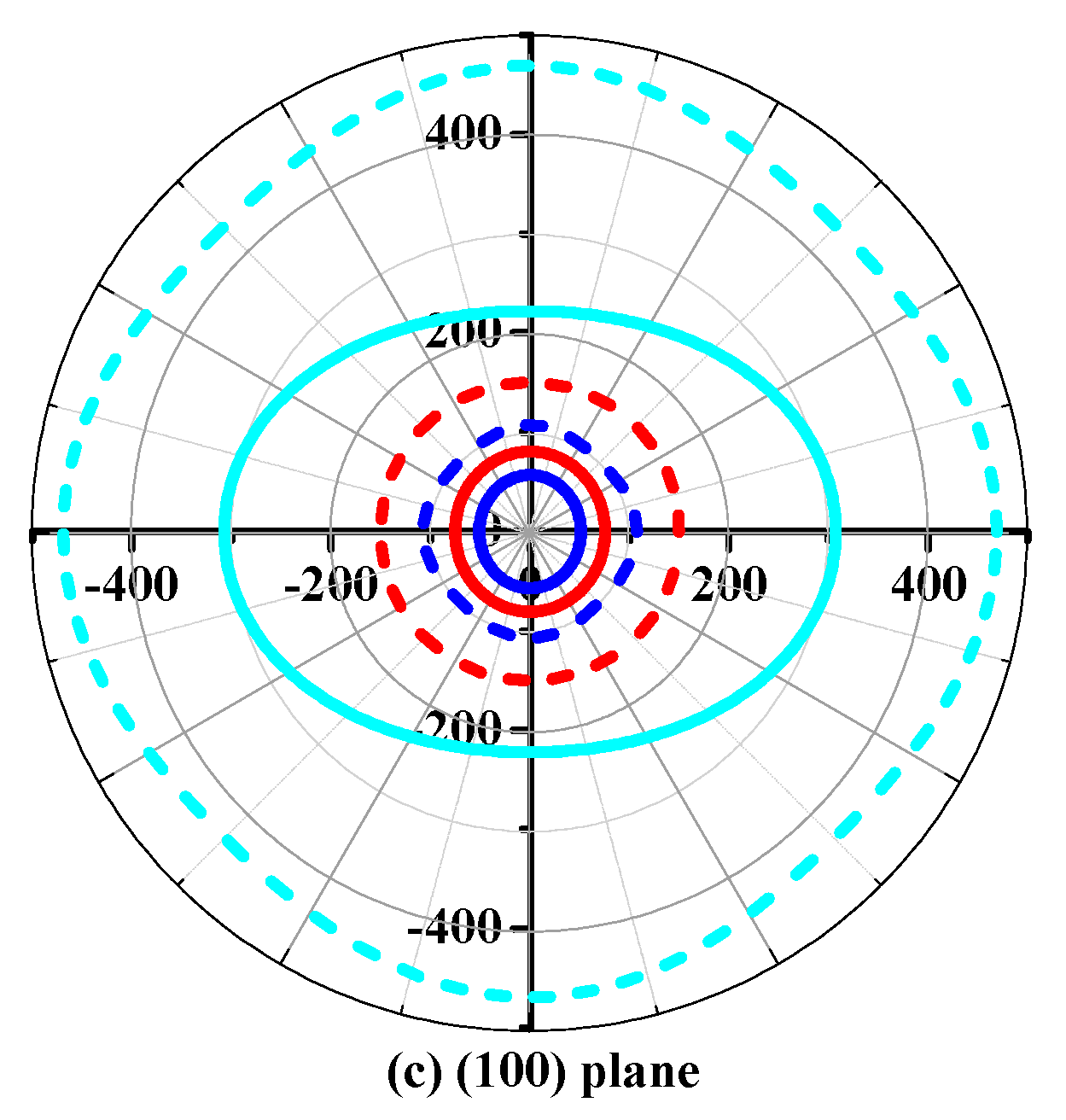
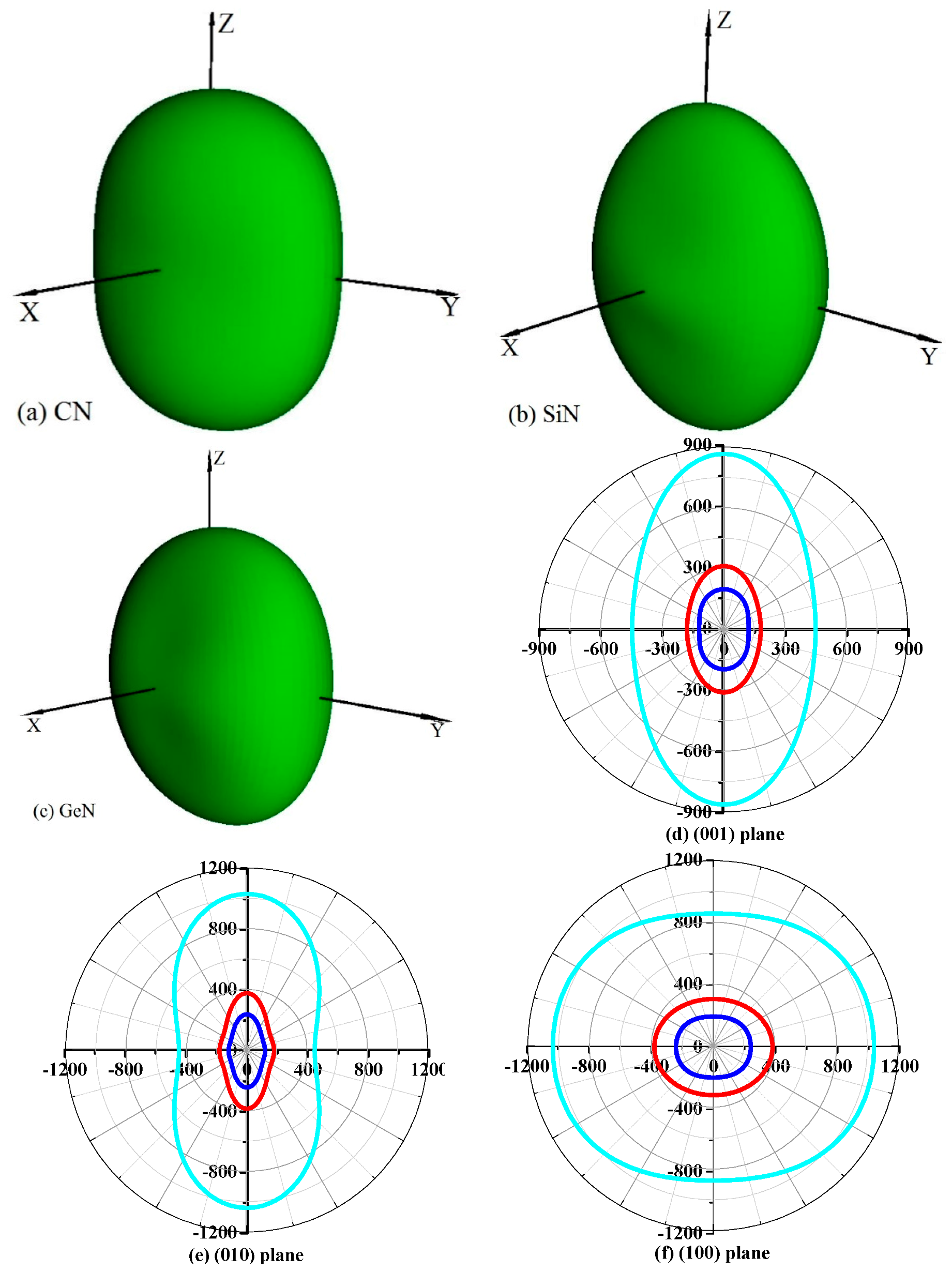
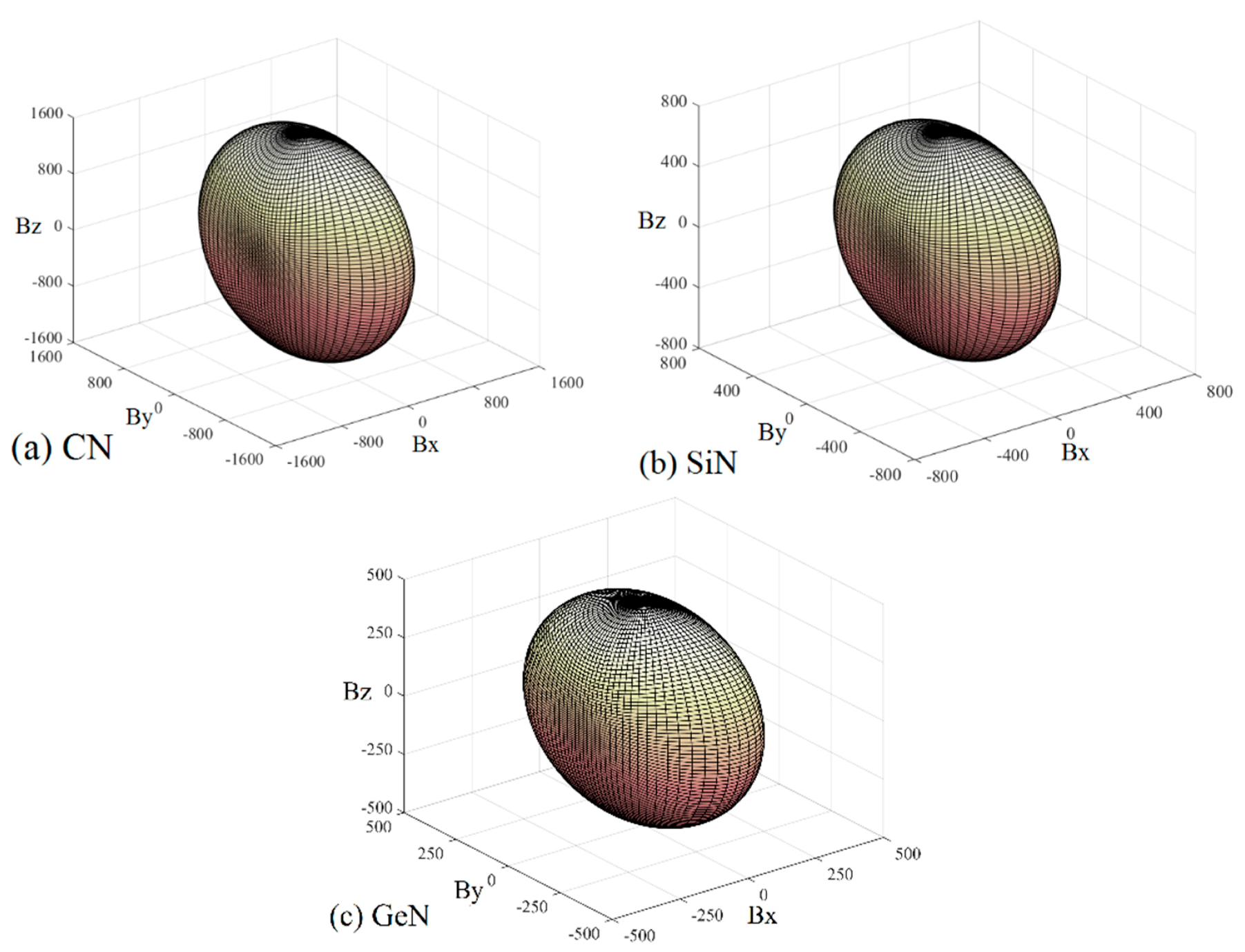
| Materials | PBE | PBEsol | CA-PZ | PBE + D | ||||||||
|---|---|---|---|---|---|---|---|---|---|---|---|---|
| a | b | c | a | b | c | a | b | c | a | b | c | |
| CN | 5.504 | 4.395 | 4.041 | 5.461 | 4.384 | 4.029 | 5.402 | 4.352 | 3.998 | 5.484 | 4.385 | 4.029 |
| 5.514 1 | 4.396 | 4.041 | ||||||||||
| 5.514 2 | 4.396 | 4.041 | ||||||||||
| SiN | 7.234 | 5.341 | 7.226 | 7.339 | 5.333 | 4.867 | 7.226 | 5.257 | 4.798 | 7.281 | 5.322 | 4.856 |
| GeN | 7.831 | 5.645 | 7.578 | 7.823 | 5.625 | 5.136 | 7.578 | 5.488 | 5.011 | 7.744 | 5.610 | 5.129 |
| c-BN | 3.626 | 3.612 | 3.569 | 3.600 | ||||||||
| Diamond | 3.566 | 3.558 | 3.526 | 3.566 | ||||||||
| Materials | C11 | C12 | C13 | C22 | C23 | C33 | C44 | C55 | C66 | B | G | E | v |
|---|---|---|---|---|---|---|---|---|---|---|---|---|---|
| CN | 491 | 169 | 139 | 922 | 122 | 1080 | 469 | 307 | 222 | 356 | 319 | 771 | 0.139 |
| CN 1 | 495 | 174 | 145 | 934 | 124 | 1112 | 465 | 313 | 243 | 363 | 326 | 754 | 0.154 |
| SiN | 221 | 107 | 88 | 367 | 90 | 422 | 150 | 75 | 81 | 170 | 104 | 257 | 0.243 |
| SiN2 2 | 836 | 1269 | 397 | 313 | 407 | 386 | 879 | 0.140 | |||||
| SiN2 3 | 442 | 75 | 58 | 610 | 133 | 133 | 237 | 76 | 71 | 191 | 138 | 333 | 0.200 |
| Si3N2 4 | 261 | 97 | 68 | 152 | 73 | 190 | 0.290 | ||||||
| o-Si3N4 5 | 581 | 181 | 55 | 587 | 132 | 483 | 244 | 88 | 197 | 262 | 179 | 436 | 0.221 |
| t-Si3N4 5 | 277 | 152 | 145 | 312 | 178 | 207 | 194 | 126 | 311 | 0.233 | |||
| m-Si3N4 5 | 241 | 39 | 139 | 457 | 55 | 358 | 88 | 128 | 86 | 165 | 104 | 259 | 0.239 |
| GeN | 159 | 85 | 69 | 243 | 55 | 272 | 107 | 51 | 57 | 119 | 70 | 176 | 0.255 |
| GeN2 3 | 260 | 40 | 22 | 350 | 94 | 145 | 138 | 45 | 44 | 119 | 85 | 205 | 0.210 |
| o-Ge3N4 6 | 203 | 122 | 305 | 0.250 | |||||||||
| t-Ge3N4 6 | 147 | 87 | 218 | 0.253 | |||||||||
| m-Ge3N4 6 | 124 | 73 | 183 | 0.254 |
| Materials | CN | SiN | GeN | |
|---|---|---|---|---|
| ρ | 3.536 | 2.922 | 5.039 | |
| (100) | (100)vl | 11,784 | 8697 | 5617 |
| (010)vtl | 7927 | 5265 | 3363 | |
| (001)vt2 | 9318 | 5066 | 3181 | |
| (010) | (010)vl | 16,148 | 11,207 | 6944 |
| (100)vt1 | 7927 | 5265 | 3363 | |
| (001)vt2 | 11,517 | 7165 | 4608 | |
| (001) | (001)vl | 17,477 | 12,018 | 7347 |
| (100)vt1 | 9318 | 5066 | 3181 | |
| (010)vt2 | 11,517 | 7165 | 4608 | |
| vl | 14,865 | 10,278 | 6491 | |
| vt | 9498 | 5966 | 3727 | |
| vm | 10,437 | 6620 | 4140 | |
| ΘD | 1702 | 863 | 508 |
© 2017 by the authors. Licensee MDPI, Basel, Switzerland. This article is an open access article distributed under the terms and conditions of the Creative Commons Attribution (CC BY) license (http://creativecommons.org/licenses/by/4.0/).
Share and Cite
Ma, Z.; Liu, X.; Yu, X.; Shi, C.; Wang, D. Mechanical, Anisotropic, and Electronic Properties of XN (X = C, Si, Ge): Theoretical Investigations. Materials 2017, 10, 912. https://doi.org/10.3390/ma10080912
Ma Z, Liu X, Yu X, Shi C, Wang D. Mechanical, Anisotropic, and Electronic Properties of XN (X = C, Si, Ge): Theoretical Investigations. Materials. 2017; 10(8):912. https://doi.org/10.3390/ma10080912
Chicago/Turabian StyleMa, Zhenyang, Xuhong Liu, Xinhai Yu, Chunlei Shi, and Dayun Wang. 2017. "Mechanical, Anisotropic, and Electronic Properties of XN (X = C, Si, Ge): Theoretical Investigations" Materials 10, no. 8: 912. https://doi.org/10.3390/ma10080912




